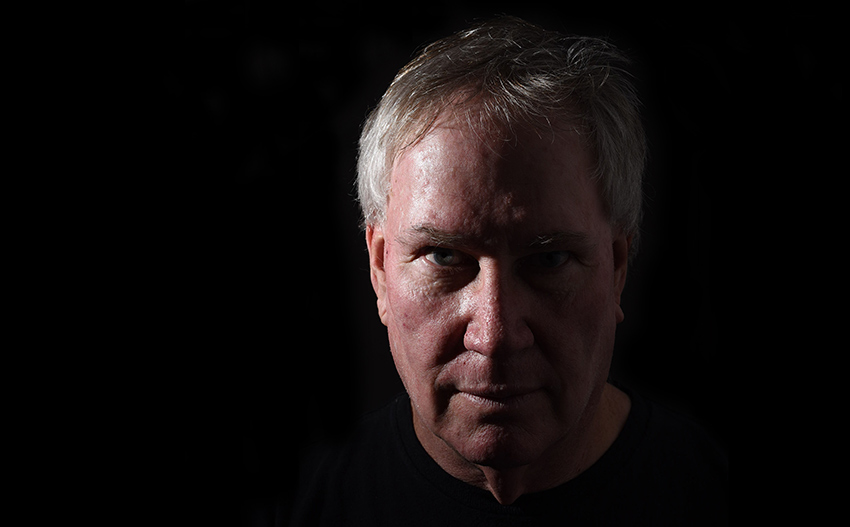6 April 2018
Second Act: Capturing the Speed of Light
by Kelly Davis

Image by Sarah Sieman
Norm Dewitt grew up riding and racing motorbikes and at a young age developed a keen interest in race cars. Though he earned a degree in architecture, he never gave up his passion for fast-moving vehicles and eventually started writing about racing for national publications.
 When Dewitt’s architecture career came to an end, he sought out a new line of work; an aptitude test pointed him to photography and to a joint Extension / San Diego Workforce Partnership program that provided the funding for him to pursue a Professional Certificate in Photography. The courses “raised my game in ways that I didn’t even know my game was lacking,” he says. Now he’s able to shoot professional-level photos to accompany his writing. Earlier this year, he published his third book, Making it Faster II, which explores the evolution of race cars, and says he’s got nearly enough material for a fourth book.
When Dewitt’s architecture career came to an end, he sought out a new line of work; an aptitude test pointed him to photography and to a joint Extension / San Diego Workforce Partnership program that provided the funding for him to pursue a Professional Certificate in Photography. The courses “raised my game in ways that I didn’t even know my game was lacking,” he says. Now he’s able to shoot professional-level photos to accompany his writing. Earlier this year, he published his third book, Making it Faster II, which explores the evolution of race cars, and says he’s got nearly enough material for a fourth book.
Tell us a little bit about yourself. You’ve been racing cars and boats for quite awhile?
I’ve pretty much been racing cars or sailboats for my whole life. I started with motocross bikes, but I got my degree in architecture and had been working in that field for years. I started missing the auto racing, so I started doing stories with the teams for various magazines and that included motorcycle racing as well—probably more motorcycle racing than anything else, but also a great deal of car racing stories.
So you were writing stories. How did photography come into the mix?
Initially I had no inclination for photography at all, but I quickly found out that sourcing images and paying photographers was a budget killer. So, I needed to raise my game and learn a little bit about photography. This all coincided with the emergence of affordable digital cameras. So that made it much more possible for somebody who hadn’t a clue to take, you know, a thousand pictures and get a couple of good ones.
When did you decide to study photography?
I was working with an architecture/engineering firm pretty much full time for 35 years and I got laid off. They told me [at the career center], “Well, we could retrain you.” You take all these [aptitude] tests … and the one where they lined up was photography. That was very handy because I was proficient at action photography, being at races all the time, but I was a one-trick pony—that was all I really knew. By going through the UC San Diego Extension program, I learned an enormous amount about digital manipulation through Lightroom and printing, and through Photoshop—then of course all the things like portrait photography, using Speedlights and things that I really had no experience with. I even got to take a film photography class and [learned about] working in a darkroom. It basically opened my eyes to the entire spectrum of photographic options and talents that I never had had before.
Is there any course that stands out? Lessons that you keep going back to?
I picked up so many little things here and there. I would say probably the core is Photo I, II and III. Photo III is where you build your portfolio. That was important. Those three courses are the meat of the matter. Everything else is specific skills that help you build your overall capabilities. But those are probably the key core classes.
What advice would you give to someone who's thinking about taking a photography course at Extension?
Every class, I came away with a few tricks and things that I didn't know before—color management with printers and things like that. Stuff that I didn’t have a clue on. [The film photography class] was really cool because it enables you to learn and experiment with film photography and learn what you can do in a darkroom to modify the images. And then if you see fit, you can scan those and then go in and start tweaking everything [digitally]. I’m not a purist; I don't say, like, it has to be pure film. You can come up with some interesting things working back and forth between the two mediums.
How has your experience at Extension helped your career?
It has raised my game in ways that I didn’t even know my game was lacking. You don't know what you don't know. And that was what I came with more than anything else—I learned a lot of things that I wasn't even aware of. It helped me a lot with a career that I continue to pursue.
Learn more about the photography courses and programs at Extension on our website, or contact the department at ahl@ucsd.edu / (858) 534-5760.